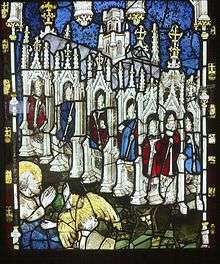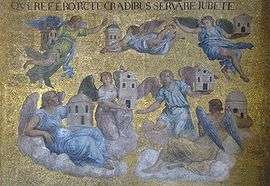Seven churches of Asia
The Seven Churches of Revelation, also known as the Seven Churches of the Apocalypse and the Seven Churches of Asia, are seven major churches of Early Christianity, as mentioned in the New Testament Book of Revelation.
Description
According to Revelation 1:11, on the Greek island of Patmos, Jesus Christ instructs John of Patmos to: "Write on a scroll what you see and send it to the seven churches: to Ephesus, and to Smyrna, and to Pergamum, and to Thyatira, and to Sardis, and to Philadelphia, and to Laodicea."[1]
The "churches" in this context refers to the community or local congregations of Christians living in each city, and not merely to the building or buildings in which they gathered for worship.[2][3]
The Churches

The seven Churches are named for their locations. The Book of Revelation provides descriptions of each Church.
- Ephesus (Revelation 2:1-7) -- The church known for having labored hard and not fainted, and separating themselves from the wicked; admonished for having forsaken its first love (2:4)
- Smyrna (Revelation 2:8-11) -- The church admired for its tribulation and poverty; forecast to suffer persecution (2:10)
- Pergamum (Revelation 2:12-17) -- The church where 'Satan's seat' or 'throne' is; needed to repent of allowing false teachers (2:16)
- Thyatira (Revelation 2:18-29) -- The church known for its charity, whose "latter works are greater than the former;" held the teachings of a false prophetess (2:20)
- Sardis (Revelation 3:1-6) -- The church that has a good name; cautioned to fortify itself and return to God through repentance (3:2-3)
- Philadelphia (Revelation 3:7-13) -- The church steadfast in faith, that had kept God's word and endured patiently (3:10)
- Laodicea, near Denizli (see Laodicean Church) (Revelation 3:14-22) -- The church that was lukewarm and insipid (to God) (3:16)
Seven messages
The letters follow a common pattern. For example: the Lord first addresses each church and identifies himself,[4] then defines things that he knows about the church in question.[5] After this, a challenge or reproach is given,[6] followed by a promise.[7] In all seven cases the admonition is included, "He who has an ear, let him hear what the Spirit says to the churches",[8] although sometimes this comes before the promise and sometimes after.
Although the letters differ in length in accord with the needs of each community, all conclude with an appeal to hold fast and to listen to what the Spirit is saying to the churches. Each church is promised that everyone who conquers will be rewarded by Christ.
Some historicists typically interpret the seven churches as representing seven different periods in the history of the Western Church from the time of Paul until the return of Jesus Christ.[9] Scofield states that "these messages by their very terms go beyond the local assemblies mentioned."[10] He is of the opinion that the letters have a prophetic purpose disclosing the seven phases of the spiritual history of the Church. Other writers, such as Clarence Larkin,[11] Henry Hampton Halley,[12] Merrill Unger,[13] and William M. Branham[14] also have posited the view that the seven churches preview the history of the global Church.

Historicism has been criticized by the Eastern Orthodox Fr. Dimitri Cozby, who writes that historicists take a greatly oversimplified view of church history: "Since dispensationalism is Protestant in origin its 'Church history' is strictly Western. The dispensations take into account almost nothing of Orthodox history after the period of the early councils which we share with the West."[15]
Angels of the churches
Chapters 2-3 of the Revelation have specific messages for each of the seven churches. The message of each of the seven letters is directed to the angel of the particular church that is mentioned.
Origen[16] explains that these "angels" are the guardian angels of the churches, a view upheld by Henry Alford. But Epiphanius[17] explicitly rejects this view, and, in accordance with the imagery of the passage, explains it as the bishops.
John sees a vision of the Son of man, who walks among seven lampstands and has seven stars in his right hand. Revelation 1:20 states that "The seven stars are the angels of the seven churches, and the seven lampstands are the seven churches." The comparison of a teacher to a star is scriptural.[18]
Augustine of Hippo's reason for interpreting angels of the churches as the prelates of the church is that St. John speaks of them as falling from their first charity, which is not true of the angels.[19][20] Others would say that the falling away relates to the churches, not to the messengers, as each of the seven letters conclude with the words "He who has an ear, let him hear what the Spirit says to the churches."
the Amplified Bible states that Revelation 2:2 through to 3:18, “your” and “you” are in the singular, referring to the angel of each church. Much of what is said is rebuke and admonishment, so if the angels are heavenly beings, they may serve in some way as representatives of the sinful people in their churches. Jewish tradition maintained that every nation and individual has a guardian angel, and that when God is about to punish a nation, He first punishes its angel. There is even a story of Michael, the guardian angel of Israel, being rebuked by God for the sins committed in the time of Ezekiel. So the original readers of Revelation might have assumed that the angels here are the guardian angels of the individual churches, sharing responsibility for the actions of the members.
In the New Testament, the Greek word for angels (άγγελος) is not only used for heavenly angels, but also used for human messengers, such as John the Baptist (Matthew 11:10,Mark 1:2,Luke 7:27) and God's prophets (Revelation 22:8-9)[21] C.I. Scofield has noted that "The natural explanation of the 'messengers' is that they were men sent by the seven churches to ascertain the state of the aged apostle ... but they figure any who bear God's messages to a church."[22]
See also
References
- ↑ Revelation 1:11
- ↑ John (1994). Barbara Aland; Kurt Aland; Johannes Karavidopoulos; Carlo M. Martini; Bruce M. Metzger, eds. The Greek New Testament. Deutsche Bibelgesellschaft.
- ↑ Walter Bauer (1979). William F. Arndt; F. Wilbur Gingrich; Frederick W. Danker, eds. A Greek-English Lexicon of the New Testament and Other Early Christian Literature. University of Chicago Press.
- ↑ 2:1, 8, 12, 18; 3:1, 7, 14
- ↑ 2:2-3, 9, 13, 19; 3:1, 8, 15-17
- ↑ 2:4-5, 10, 14-16, 20-25; 3:2-3, 9-11, 18-20
- ↑ 2:7, 10-11, 17, 26-28; 3:4-5, 12, 20-21.
- ↑ 2:7, 11, 17, 29; 3:6, 13, 22
- ↑ Unger's Bible Dictionary (Chicago: Moody Press, 1975), p924
- ↑ Scofield, W. I., The Scofield Study Bible (New York: Oxford University Press, 1996) p1331
- ↑ "Chapter XXII". www.preservedwords.com. Retrieved 2017-01-06.
- ↑ Halley, H. H., Halley's Bible Handbook (Grand Rapids, MI: Zondervan, 1978), p688
- ↑ Unger, M. F., Unger's Bible Dictionary (Chicago: Moody Press, 1975), p924
- ↑ Branham, W. M., An Exposition of the Seven Church Ages (Jeffersonville, Indiana: Voice of God Recordings) 2005
- ↑ "WHAT IS 'THE RAPTURE'? (PART 1 OF 2)".
- ↑ Hom., xiii in Luc., and Hom., xx in Num.
- ↑ Hær., xxv.
- ↑ Dan., xii, 3.
- ↑ Ep., xliii (al. clxii), n. 22.
- ↑ Angels of the Churches, Catholic Encyclopedia
- ↑ Merrill Unger, Unger's Bible Dictionary, (Chicago: Moody Press, 1975) p52
- ↑ Scofield, W. I., The Scofield Study Bible (New York: Oxford University Press, 1996) p1331
Further reading
- Halley, H. H., Halley's Bible Handbook (Grand Rapids, MI: Zondervan, 1978), p684
- Scofield, C. I., The Scofield Reference Bible (Oxford: Oxford University Press, 1967), p1332
- Ramsay, W. M. (1904). The Letters to the Seven Churches of Asia. Hodder & Stoughton.
- Hemer, Colin J. The Letters to the Seven Churches of Asia in Their Local Setting (JSOT Press, 1989), p283
External links
- Catholic Encyclopedia: Angels of the Churches
- Catholic Encyclopedia: Asia Minor, see section titled "Spread of Christianity in Asia Minor"
- Branham, W. M., An Exposition of the Seven Church Ages, Voice of God Recordings, Jeffersonville, Indiana, 1965.
- The True Trend Of the Church As Viewed Through Revelation Chapters 2 & 3 by Pastor Rocky Veach
![]()

